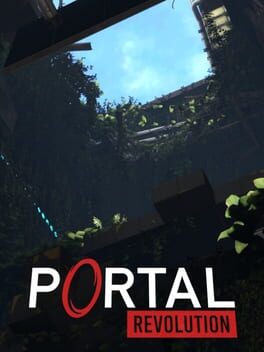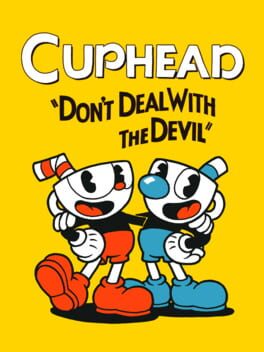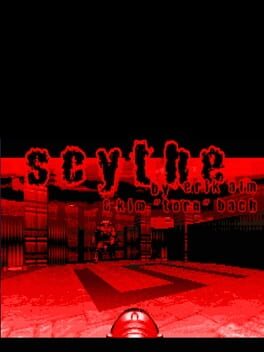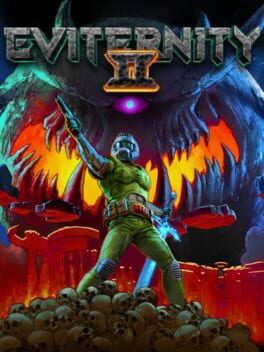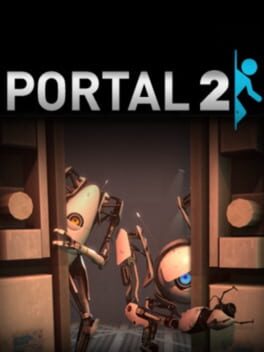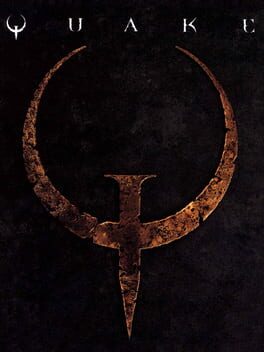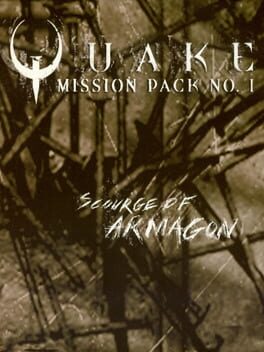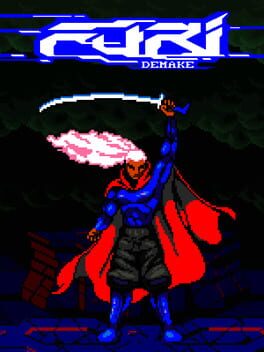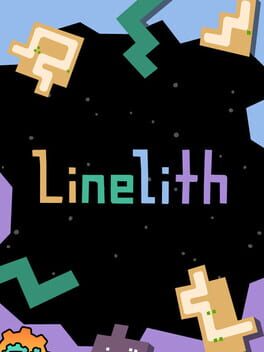Retro
79 Reviews liked by Retro
Portal: Revolution
2024
Cuphead
2017
it feels somewhat rare that an indie game really captures a retro style in a way that does more than pay lip-service to its predecessors. shovel knight was one of those games: a pitch-perfect recreation of NES-style action challenges stripped away of the mechanical uncertainty of the actual games of that era. cuphead captures that for the run-and-gun in a way that makes it not only a loving tribute but a legitimate cornerstone in the genre.
cuphead feels borne by a rigorous design methodology that demonstrates a deep understanding of the fundamentals of boss design in a 2D space. each fight is undergirded by the movement and platform features; this is generally the unifying trait. plenty of fights take place on a featureless flat ground, but very quickly wrinkles such as scrolling, conveyors, limited platforms, or combinations of these are introduced. a great late-game example is the ghost train stage that features of a platform that can and must be moved between left, center, and right using parry controls. these establish for the player the laws of their dominion so to speak: what space can the player leverage? what options exist at any given time to dodge a certain obstacle?
with each phase then comes the primary attack. bosses generally lack dynamic reactive capabilities unlike a human, so they are incapable of mindgames generally speaking. thus, in virtually all boss fights the boss cycles between random attacks that the player must apply a counterstrategy against. in modern games the design parlance is as such: windup animation begets the attack proper begets an opening for a player to either 1) rest if their counterstrategy is not efficient enough to yield a counterattack or 2) counterattack. too unthreatening and the player barely needs to muster a counterattack, and too overpowered and the player will have no time to respond. cuphead weaves in a truly surprising variety of primaries to challenge the player: the enemy may momentarily remove the player's control of the space, such as with the cat at the end of the rat tank fight batting its paws to swat the right and left sides of the screen, or perhaps the enemy creates antagonistic autonomous elements that force the player to utilize their spatial reasoning and pattern recognition to deduce a projectile's movement habits and shift their position accordingly, such as in the bee queen's middle phase where she incorporates stochaistically-drifting geometric projectiles as well as bullets that move in a linear back-and-forth climb on either side of the screen.
primary attacks on their own are only a lock-and-key design principle: find the counterstrategy that works against a particular move and apply it when needed. what creates true tension in the fight are the auxillary attacks. virtually all bosses are able to separately cycle through auxillary attacks that generally involve an entirely separate on-screen entity attacking on their own accord out of sync with the primary opponent. auxillary attacks on their own already heighten the experience by creating a space-constraint intersection that forces the player to adapt their key to more than just a single lock. certain intersections of attacks may prevent successful counterattacks or force the player to fall back on safer strategies, thus making the risk-and-reward judgment more critical and ever mutating. where cuphead really succeeds is having the auxillary attacks cycle as well. it's much like having three basic collared shirts and three basic ties: the combinations they present give you nine outfits, yielding an multiplicative amount of potential attack intersections. phase one of the sea medusa fight is a great example of this: three primary attacks (either summoning ghost projectiles or bringing one of two different fish out of the water with their own projectiles) with three auxillary attacks (staggered puffer fish projectiles, a water jet that forces a positive y velocity, and bombs that explode with a octagonal bullet pattern). each on their own is manageable, but combined there is an additional level of fluidity demanded of the player with adapting on the fly to intersections they may have never seen before.
of course cuphead doesn't simply hew to these elements in every fight; it expands on them and plays with the potential they possess. take the pirate ship fight: this begins with both a small primary attack (pellets fired by the captain one by one) with an auxillary component (a barrel that moves back and forth at the top of the screen, attempting to crush the player when they pass underneath). within time the captain will begin preempting his own pellet attack with a cycle of attacks from different sources, each with their own tell: a shark that consumes the left half of the screen, small bulldog fish(?) that slide across the ground, and a squid that both creates a fountain of bullets and can turn the screen dark if not defeated in time. on its own this is a perfectly interesting fight: manage the primary and auxillary attacks while being cognizant of primary attacks from external components via tells. however, in the second phase, the ship itself begins shooting cannonballs on a timer. at this point the player must not only manage transient attacks from the captain but also track the separate rhythms of the barrel and the ship's cannonballs. these intersect in a truly polyrhythmic fashion that pushes the fight into truly challenging territory that feels immensely rewarding to lock in with.
this is also boosted by cuphead having a stellar kit and smooth controls that feel sharp without being too abrupt or linear. his ability to parry specific objects (which are colored pink to distinguish them) adds a scale of mastery of many bullet patterns, with basic familiarity only yielding the ability to dodge while a complete understanding allows navigation to specific bullets for a parry and the reward of extra super meter. the super meter attacks are all rather useful and feel well balanced, though for the full-meter arts I can't really imagine someone using anything other than invincibility. however, I found myself legitimately switching out his shots and charms for different fights, which is not to say I found all of the variety useful (I mainly stuck to chaser and spread along with the smoke dodge and one extra heart depending on the fight), but to require a level of specificity in strategy for each fight encourages me to experiment more than I may otherwise. there are virtually no points of frustration I can attribute to a failure in the controls or a lack of a specific tool; almost every time I was stumped on a particular counterstrategy I always eventually worked something out even if it wasn't optimal.
I would really go as far as to say I don't think cuphead has any particular failings or even elements of unfair frustration that I can think of. while an immensely challenging experience, the primary and auxillary attacks are synergistic in such a way that a given intersection can't truly render an attack undodgeable or debilitating. never did I feel like a particular portion was just inserted because it felt cool or to fill space; rather, every bit of the game feels handled with care and finesse. the dragon fight was the peak of this for me... that particular fight walled me and put me off the game quite a bit. while the exasperation I felt was valid, I could never pinpoint a particular aspect that really felt unfair to me. at the end of the day, those projectiles that explode into smaller projectiles when hit really preyed on my spray-and-pray instincts in a way that punished me (and many others I assume) far more than most games are willing to muster. if I had to name one little thing that did feel off to me, it was the platforms during the bee queen fight. the scrolling part and random gaps don't bother me, but their collision box doesn't feel quite lined up with the art, which sometimes led to me falling randomly in confusing ways.
I do wish the flying stages had the same level of customization as the ground stages, but understandably that's a scope issue and not something I would expect from a small production. the non-boss levels also feel a bit perfunctory, but they are all still fun and only necessary for collecting coins for purchasing items in the shop. both of these won't get in the way of anyone looking to experience this: the core of the gameplay is still the tremendous boss fights. this has given me a a nice little kick in the pants to go back and dive into the early 16-bit fundamental works that helped mold this into the genius showpiece that it is.
cuphead feels borne by a rigorous design methodology that demonstrates a deep understanding of the fundamentals of boss design in a 2D space. each fight is undergirded by the movement and platform features; this is generally the unifying trait. plenty of fights take place on a featureless flat ground, but very quickly wrinkles such as scrolling, conveyors, limited platforms, or combinations of these are introduced. a great late-game example is the ghost train stage that features of a platform that can and must be moved between left, center, and right using parry controls. these establish for the player the laws of their dominion so to speak: what space can the player leverage? what options exist at any given time to dodge a certain obstacle?
with each phase then comes the primary attack. bosses generally lack dynamic reactive capabilities unlike a human, so they are incapable of mindgames generally speaking. thus, in virtually all boss fights the boss cycles between random attacks that the player must apply a counterstrategy against. in modern games the design parlance is as such: windup animation begets the attack proper begets an opening for a player to either 1) rest if their counterstrategy is not efficient enough to yield a counterattack or 2) counterattack. too unthreatening and the player barely needs to muster a counterattack, and too overpowered and the player will have no time to respond. cuphead weaves in a truly surprising variety of primaries to challenge the player: the enemy may momentarily remove the player's control of the space, such as with the cat at the end of the rat tank fight batting its paws to swat the right and left sides of the screen, or perhaps the enemy creates antagonistic autonomous elements that force the player to utilize their spatial reasoning and pattern recognition to deduce a projectile's movement habits and shift their position accordingly, such as in the bee queen's middle phase where she incorporates stochaistically-drifting geometric projectiles as well as bullets that move in a linear back-and-forth climb on either side of the screen.
primary attacks on their own are only a lock-and-key design principle: find the counterstrategy that works against a particular move and apply it when needed. what creates true tension in the fight are the auxillary attacks. virtually all bosses are able to separately cycle through auxillary attacks that generally involve an entirely separate on-screen entity attacking on their own accord out of sync with the primary opponent. auxillary attacks on their own already heighten the experience by creating a space-constraint intersection that forces the player to adapt their key to more than just a single lock. certain intersections of attacks may prevent successful counterattacks or force the player to fall back on safer strategies, thus making the risk-and-reward judgment more critical and ever mutating. where cuphead really succeeds is having the auxillary attacks cycle as well. it's much like having three basic collared shirts and three basic ties: the combinations they present give you nine outfits, yielding an multiplicative amount of potential attack intersections. phase one of the sea medusa fight is a great example of this: three primary attacks (either summoning ghost projectiles or bringing one of two different fish out of the water with their own projectiles) with three auxillary attacks (staggered puffer fish projectiles, a water jet that forces a positive y velocity, and bombs that explode with a octagonal bullet pattern). each on their own is manageable, but combined there is an additional level of fluidity demanded of the player with adapting on the fly to intersections they may have never seen before.
of course cuphead doesn't simply hew to these elements in every fight; it expands on them and plays with the potential they possess. take the pirate ship fight: this begins with both a small primary attack (pellets fired by the captain one by one) with an auxillary component (a barrel that moves back and forth at the top of the screen, attempting to crush the player when they pass underneath). within time the captain will begin preempting his own pellet attack with a cycle of attacks from different sources, each with their own tell: a shark that consumes the left half of the screen, small bulldog fish(?) that slide across the ground, and a squid that both creates a fountain of bullets and can turn the screen dark if not defeated in time. on its own this is a perfectly interesting fight: manage the primary and auxillary attacks while being cognizant of primary attacks from external components via tells. however, in the second phase, the ship itself begins shooting cannonballs on a timer. at this point the player must not only manage transient attacks from the captain but also track the separate rhythms of the barrel and the ship's cannonballs. these intersect in a truly polyrhythmic fashion that pushes the fight into truly challenging territory that feels immensely rewarding to lock in with.
this is also boosted by cuphead having a stellar kit and smooth controls that feel sharp without being too abrupt or linear. his ability to parry specific objects (which are colored pink to distinguish them) adds a scale of mastery of many bullet patterns, with basic familiarity only yielding the ability to dodge while a complete understanding allows navigation to specific bullets for a parry and the reward of extra super meter. the super meter attacks are all rather useful and feel well balanced, though for the full-meter arts I can't really imagine someone using anything other than invincibility. however, I found myself legitimately switching out his shots and charms for different fights, which is not to say I found all of the variety useful (I mainly stuck to chaser and spread along with the smoke dodge and one extra heart depending on the fight), but to require a level of specificity in strategy for each fight encourages me to experiment more than I may otherwise. there are virtually no points of frustration I can attribute to a failure in the controls or a lack of a specific tool; almost every time I was stumped on a particular counterstrategy I always eventually worked something out even if it wasn't optimal.
I would really go as far as to say I don't think cuphead has any particular failings or even elements of unfair frustration that I can think of. while an immensely challenging experience, the primary and auxillary attacks are synergistic in such a way that a given intersection can't truly render an attack undodgeable or debilitating. never did I feel like a particular portion was just inserted because it felt cool or to fill space; rather, every bit of the game feels handled with care and finesse. the dragon fight was the peak of this for me... that particular fight walled me and put me off the game quite a bit. while the exasperation I felt was valid, I could never pinpoint a particular aspect that really felt unfair to me. at the end of the day, those projectiles that explode into smaller projectiles when hit really preyed on my spray-and-pray instincts in a way that punished me (and many others I assume) far more than most games are willing to muster. if I had to name one little thing that did feel off to me, it was the platforms during the bee queen fight. the scrolling part and random gaps don't bother me, but their collision box doesn't feel quite lined up with the art, which sometimes led to me falling randomly in confusing ways.
I do wish the flying stages had the same level of customization as the ground stages, but understandably that's a scope issue and not something I would expect from a small production. the non-boss levels also feel a bit perfunctory, but they are all still fun and only necessary for collecting coins for purchasing items in the shop. both of these won't get in the way of anyone looking to experience this: the core of the gameplay is still the tremendous boss fights. this has given me a a nice little kick in the pants to go back and dive into the early 16-bit fundamental works that helped mold this into the genius showpiece that it is.
Scythe
2003
Scythe was a blast for me. I really loved the concept of very short maps with a fair amount of difficulty. Most of this maps can be finished in less than 5-6 minutes, but they are still challenging in a very Plutonia way. It really captures the idea of having fun playing Doom.
There are a few maps than differ from this concept of keeping things pretty short. You have two slaughter maps, a few whose length is probably the average of a Doom 2 map (Notably, MAP29 was basically Downtown but well designed, plus snow), and of course the infamous MAP28, a map that basically forces you to speedrun and finish the map within 30 seconds before you automatically die.
It’s also very interesting how this wad covers up for the whole difficulty spectrum. It ranges to a very easy difficulty in the beginning, to full pro at the very end.
Fav Maps: 19. 3000 AD / 23. Anger / 29. Hell on Earth
Worst Maps: 07. Deadly / 27. Terror / 30. Fire and Ice
Honorable mentions: Map26: Fear (I dislike slaughter maps but this one was a surprisingly fun one to play with) / Map28: Run from It (althought it’s pretty hated, i actually enjoyed the “speedrun for your life” idea)
There are a few maps than differ from this concept of keeping things pretty short. You have two slaughter maps, a few whose length is probably the average of a Doom 2 map (Notably, MAP29 was basically Downtown but well designed, plus snow), and of course the infamous MAP28, a map that basically forces you to speedrun and finish the map within 30 seconds before you automatically die.
It’s also very interesting how this wad covers up for the whole difficulty spectrum. It ranges to a very easy difficulty in the beginning, to full pro at the very end.
Fav Maps: 19. 3000 AD / 23. Anger / 29. Hell on Earth
Worst Maps: 07. Deadly / 27. Terror / 30. Fire and Ice
Honorable mentions: Map26: Fear (I dislike slaughter maps but this one was a surprisingly fun one to play with) / Map28: Run from It (althought it’s pretty hated, i actually enjoyed the “speedrun for your life” idea)
Eviternity II
2023
What an unbeliavable surprise to top off the year.
Were just a few months shy of Eviternity's 5th anniversary (holy shit how has it been this long), what many, including myself proclaimed to be the greatest megawad of all time. I've got nothing but praise to give it's sequel.
Maps are gorgeous, layouts simultaneously feel unique and straight forward, both combat encounters & puzzles are well thought out, dehacked monsters feel completely fair, and the midis are excellent.
Highlights are Maps 1,3,4,8,9,10,14,18, and especially 32. 32 might be my favorite level released in any wad, ever. 36 is also noteworthy for effectively being a sunlust map in terms of cruelty towards the player.
That being said, barring maybe Map33 (you'll know why when you get to it) you could release any 3-4 maps as it's own seperate entity and it would end up being a noteworthy wad of the year.
Nevermind greatest megawad anymore, Eviternity 2 is an easy contender for greatest pwad of all time. An absolute MUST play for anyone interested and/or invested in Doom's modding scene.
Were just a few months shy of Eviternity's 5th anniversary (holy shit how has it been this long), what many, including myself proclaimed to be the greatest megawad of all time. I've got nothing but praise to give it's sequel.
Maps are gorgeous, layouts simultaneously feel unique and straight forward, both combat encounters & puzzles are well thought out, dehacked monsters feel completely fair, and the midis are excellent.
Highlights are Maps 1,3,4,8,9,10,14,18, and especially 32. 32 might be my favorite level released in any wad, ever. 36 is also noteworthy for effectively being a sunlust map in terms of cruelty towards the player.
That being said, barring maybe Map33 (you'll know why when you get to it) you could release any 3-4 maps as it's own seperate entity and it would end up being a noteworthy wad of the year.
Nevermind greatest megawad anymore, Eviternity 2 is an easy contender for greatest pwad of all time. An absolute MUST play for anyone interested and/or invested in Doom's modding scene.
Hexen II
1997
Hexen II understands 3d exploration like no other game. you zoom through enemies relatively quickly compared to the amount of time you spend exploring the areas that then become completely empty for the rest of the pretty long chapters, especially when compared to its contemporaries. it's uncanny and reflects the state of the game's reality at that point. impressive how even though every chapter reflects that feeling, Blackmarsh is still the most unnerving. empty churches, stores, and houses, all of which you can (and often need to) enter to search for a piece of the convoluted puzzles. you rid the area of enemies, but the people who lived there won't come back until you get rid of Eidolon.
having finished it alone and in coop, i noticed that both approaches still work in the atmosphere's favor. looking through areas with friends makes exploring Hexen II feel almost archaeological. your group starts piecing together structures and their meanings to the people who used to live there, and every time someone finds an item, a discussion as to what it means follows it. you need to understand what it does/why you need it in order to know where to place it somewhere.
the different classes also contribute to that feeling. the Necromancer is there to regain his status as the most fearful ruler and the Assassin is there for glory, while the Crusader had to abandon his monastery to fight and the Paladin has nowhere else to look after the slaughter of his village. even though half of these characters are there for selfish reasons, all four still work together to restore the world. the game doesn't make an effort to connect them as allies explicitly but the emergent cooperation between players achieves the same effect.
i don't think i'll ever find another game with such strong and understated direction choices. it's harsh, cold, and forlorn - but also leaves space for the warmth of perseverance.
having finished it alone and in coop, i noticed that both approaches still work in the atmosphere's favor. looking through areas with friends makes exploring Hexen II feel almost archaeological. your group starts piecing together structures and their meanings to the people who used to live there, and every time someone finds an item, a discussion as to what it means follows it. you need to understand what it does/why you need it in order to know where to place it somewhere.
the different classes also contribute to that feeling. the Necromancer is there to regain his status as the most fearful ruler and the Assassin is there for glory, while the Crusader had to abandon his monastery to fight and the Paladin has nowhere else to look after the slaughter of his village. even though half of these characters are there for selfish reasons, all four still work together to restore the world. the game doesn't make an effort to connect them as allies explicitly but the emergent cooperation between players achieves the same effect.
i don't think i'll ever find another game with such strong and understated direction choices. it's harsh, cold, and forlorn - but also leaves space for the warmth of perseverance.
Pretty hard game to review, I felt all kinds of way while playing it. The new abilities are a step up from BOTW and all really good, the story has some great moments and the gameplay loop created by the previous game still holds up super well.
Unfortunately I don't think the decision of reusing the map paid off, especially because of how much repetition in content there is in the stuff that is new. The depths, while a cool concept and great at first, is way too big with very few things to do and rewards that amount to dlcs from the previous game, which are just not satisfying at all to find. The sky islands are definitely better but there's so much repetition in them with the same concepts being used multiple times until you know exactly what you're going to find based on the shape of the island, with a few exceptions.
The story is probably one of my major gripes with it, as it overlooks a lot of what we experienced in BOTW. What's even more perplexing is its failure to acknowledge integral aspects within ITS OWN STORYLINE, which is baffling to me. I don't want to get into spoilers but having so many quests framed around investigating something you can learn early in the game with absolutely no reactivity is very immersion breaking.
Ultimately this is a good game that disappointed me in a lot of ways, and I don't think it comes close to reaching the revolutionary status that BOTW achieved, even if it improved it in some ways. Also very annoying they had so many years to fix flurry rush and it's still just as inconsistent as it was before.
Unfortunately I don't think the decision of reusing the map paid off, especially because of how much repetition in content there is in the stuff that is new. The depths, while a cool concept and great at first, is way too big with very few things to do and rewards that amount to dlcs from the previous game, which are just not satisfying at all to find. The sky islands are definitely better but there's so much repetition in them with the same concepts being used multiple times until you know exactly what you're going to find based on the shape of the island, with a few exceptions.
The story is probably one of my major gripes with it, as it overlooks a lot of what we experienced in BOTW. What's even more perplexing is its failure to acknowledge integral aspects within ITS OWN STORYLINE, which is baffling to me. I don't want to get into spoilers but having so many quests framed around investigating something you can learn early in the game with absolutely no reactivity is very immersion breaking.
Ultimately this is a good game that disappointed me in a lot of ways, and I don't think it comes close to reaching the revolutionary status that BOTW achieved, even if it improved it in some ways. Also very annoying they had so many years to fix flurry rush and it's still just as inconsistent as it was before.
Difficulty curve was a little wonky, but co-op in general had some cool ideas. Not all of them were stellar, but they definitely made us think in general. The puzzles are the strongest part of Portal 2, so I don't mind blasting ~40 of them without much break for story or anything, though it's noticeably a little dryer. Teasing a boss fight and then just ending on nothing (for DLC) was kind of lame.
Quake
1996
ENG: The true sequel to DOOM. Now you play with mouse, you can jump and there is real 3D, all of which allows you to better visualize the scenarios for combat. Combat is much more methodical than DOOM since you have to be more careful because you have to shoot one enemy at a time and our protagonist is weaker and the enemies are more resistant.
It also has a very marked medieval scenarios, an oppressive soundtrack and a color palette that rarely leaves the brown.
ESP: La verdadera secuela de DOOM. Ahora se juega con mouse, se puede saltar y hay 3D real, todo esto lo cual permite visualizar mejor los escenarios para el combate. Combate que es mucho más metódico que DOOM puesto que hay que ir con más cuidado al tener que disparar a un enemigo a la vez y ser nuestro protagonista más debil y los enemigos más resistentes.
También tiene unos escenarios medievales muy marcados, una banda sonora opresiva y una paleta de colores que rara vez deja lo marrón.
It also has a very marked medieval scenarios, an oppressive soundtrack and a color palette that rarely leaves the brown.
ESP: La verdadera secuela de DOOM. Ahora se juega con mouse, se puede saltar y hay 3D real, todo esto lo cual permite visualizar mejor los escenarios para el combate. Combate que es mucho más metódico que DOOM puesto que hay que ir con más cuidado al tener que disparar a un enemigo a la vez y ser nuestro protagonista más debil y los enemigos más resistentes.
También tiene unos escenarios medievales muy marcados, una banda sonora opresiva y una paleta de colores que rara vez deja lo marrón.
Scourge of Armagon is a must. Definitely. I mean, a lot has been said about how Quake’s fantastic gameplay was kinda degraded by it’s flawed level design (you can read my review on Quake, where i basically agreed on that idea). This mission pack, released a year later, is a more than succesful attempt at redeeming those flaws.
There are many things to say here. First of all: Aesthetically, they decided to bring some thematic cohesiveness throughout the episodes. That’s why the first one is essentially a tech base episode, and the second a medieval one, while the third is pretty much a mix of both. Secondly, i think they administrated vanilla textures in such a masterful way that they basically destroyed the “Quake is too brown” meme.
They also incorporated some very interesting evironment interaction, with certain exploding walls, demolishing structures and such. I also like the vertical design some of these levels have, especially those where you have to go from a higher point to a lower one, somehow resembling a slow descent to hell, which is somehow a very proper metaphor.
In terms of gameplay, some people seem to claim that a few levels get too cerebral or complicated at some point. While this might be true, i have to say that, in my case, i never really got lost wandering around in circles trying to find an exit after killing 100% of the enemies. That actually happened to me many times in the original Quake, instead. It’s a very overwhelming and exhausting feeling, and is one of the reasons i didn’t like many of the original Quake maps.
Probably some of those complex moments are mostly found in the third episode, which is in many ways the weakest (with the exception of HIP3M1 and HIP3M) but despite that, these levels just flow very organically, and with very little backtracking, just the perfect amount of it.
The balance is just great. You’ll have a lot of deadly encounters and traps filled with enemies in a Plutonia way. Yet, you can rest asure that the game will never get skimpy about giving you enough resources to face those encounters.
You’ll also find new weapons and enemies. The new laser canon was a very interesting addition, i couldn’t really say the same about the other two weapon additions. As for the enemies, i understand that the function of the Centroid is esentially having a chaingunner (should i say nailgunner?) added to the cast, but it’s design (a large scorpion) just seems way too unrelated to the both the grunts and the lovecraftian creatures. The gremlins are ok, not really a problem. Spike mines can be a real bitch at times. And then Armagon, i think it was nice having a final boss you can actually fight, but that Q2-Cyborg design also felt pretty unrelated to the rest of the lore.
All in all, i see myself replaying this one even more than Quake’s original game.
Favourite Maps: HIP1M3 (The Lost Mine) /HIP3M1 (Tur Torment)
Worst Maps: Althought the third episode seems to me like the one with the weakest maps, i wouldn’t call them bad really.
There are many things to say here. First of all: Aesthetically, they decided to bring some thematic cohesiveness throughout the episodes. That’s why the first one is essentially a tech base episode, and the second a medieval one, while the third is pretty much a mix of both. Secondly, i think they administrated vanilla textures in such a masterful way that they basically destroyed the “Quake is too brown” meme.
They also incorporated some very interesting evironment interaction, with certain exploding walls, demolishing structures and such. I also like the vertical design some of these levels have, especially those where you have to go from a higher point to a lower one, somehow resembling a slow descent to hell, which is somehow a very proper metaphor.
In terms of gameplay, some people seem to claim that a few levels get too cerebral or complicated at some point. While this might be true, i have to say that, in my case, i never really got lost wandering around in circles trying to find an exit after killing 100% of the enemies. That actually happened to me many times in the original Quake, instead. It’s a very overwhelming and exhausting feeling, and is one of the reasons i didn’t like many of the original Quake maps.
Probably some of those complex moments are mostly found in the third episode, which is in many ways the weakest (with the exception of HIP3M1 and HIP3M) but despite that, these levels just flow very organically, and with very little backtracking, just the perfect amount of it.
The balance is just great. You’ll have a lot of deadly encounters and traps filled with enemies in a Plutonia way. Yet, you can rest asure that the game will never get skimpy about giving you enough resources to face those encounters.
You’ll also find new weapons and enemies. The new laser canon was a very interesting addition, i couldn’t really say the same about the other two weapon additions. As for the enemies, i understand that the function of the Centroid is esentially having a chaingunner (should i say nailgunner?) added to the cast, but it’s design (a large scorpion) just seems way too unrelated to the both the grunts and the lovecraftian creatures. The gremlins are ok, not really a problem. Spike mines can be a real bitch at times. And then Armagon, i think it was nice having a final boss you can actually fight, but that Q2-Cyborg design also felt pretty unrelated to the rest of the lore.
All in all, i see myself replaying this one even more than Quake’s original game.
Favourite Maps: HIP1M3 (The Lost Mine) /HIP3M1 (Tur Torment)
Worst Maps: Althought the third episode seems to me like the one with the weakest maps, i wouldn’t call them bad really.
Fun for what it is, and hard to complain about a surprise free release like this, but it does start to show its problems on Furier mode. Some bullet patterns are very annoying to dodge because of the invisible walls, the contextual shoot/melee button really does not work well, and parry being back+attack rather than a dedicated input is annoying. Lot of things are just unclear generally, unsurprisingly not as good as the full game. Worth a quick playthrough on the base difficulty then put it down imo.
Spooktober 2023
4. Bloodstained: Curse of the Moon 2
Calling Curse of the Moon 2 the spiritual successor to Castlevania 3 is like saying wigs are the spiritual successor to hair. Looks like it, passes as it, but it’s just not the same.
I liked the first game, and as a spooky Halloween season diversion this is solid. Looks great, sounds great, the mechanics are pretty pitch-perfect. If you’ve ever thought “why don’t they make games like Castlevania anymore?” Well, they do. Here you go. My main issue here is that it outstays its welcome by substituting additional content with repetition.
I actually rented this from the library, and by the time I got to the second episode I just wanted to blast through it and get to the end. Unfortunately my lack of exploration in episode 2 meant instead of going straight to the end I had to complete a THIRD playthrough of the exact same levels, this time with different characters. I think maybe they could’ve at least remixed the actual level layouts even if they didn’t want to create new assets.
—————————
This has been a rough month for my mental health, and ‘spooktober’ hasn’t gone as planned, but I’m tentatively taking some baby steps back into normalcy. Not to get too personal but starting new medications and beginning extracurricular projects don’t always mix well with work and taking care of a new child. I’ve been recharging my emotional batteries by mindlessly playing Lego Star Wars and Call of Duty. You gotta do what you gotta do, even if for me that meant going all-in on mid. Ok Lego Star Wars is pretty fire but whatever. These games (Bloodstained: CotM 2 included), helped me out of a bit of a rut, so while things aren’t ‘better’, I’m on the road to getting there. Anyway gang I’ll be back to chugging irony poison in no time!
4. Bloodstained: Curse of the Moon 2
Calling Curse of the Moon 2 the spiritual successor to Castlevania 3 is like saying wigs are the spiritual successor to hair. Looks like it, passes as it, but it’s just not the same.
I liked the first game, and as a spooky Halloween season diversion this is solid. Looks great, sounds great, the mechanics are pretty pitch-perfect. If you’ve ever thought “why don’t they make games like Castlevania anymore?” Well, they do. Here you go. My main issue here is that it outstays its welcome by substituting additional content with repetition.
I actually rented this from the library, and by the time I got to the second episode I just wanted to blast through it and get to the end. Unfortunately my lack of exploration in episode 2 meant instead of going straight to the end I had to complete a THIRD playthrough of the exact same levels, this time with different characters. I think maybe they could’ve at least remixed the actual level layouts even if they didn’t want to create new assets.
—————————
This has been a rough month for my mental health, and ‘spooktober’ hasn’t gone as planned, but I’m tentatively taking some baby steps back into normalcy. Not to get too personal but starting new medications and beginning extracurricular projects don’t always mix well with work and taking care of a new child. I’ve been recharging my emotional batteries by mindlessly playing Lego Star Wars and Call of Duty. You gotta do what you gotta do, even if for me that meant going all-in on mid. Ok Lego Star Wars is pretty fire but whatever. These games (Bloodstained: CotM 2 included), helped me out of a bit of a rut, so while things aren’t ‘better’, I’m on the road to getting there. Anyway gang I’ll be back to chugging irony poison in no time!
Linelith
2022
Linelith is a really creative and short puzzle game, the only mechanics are walking around and drawing lines on tiles on the screen, but even in its very short run time it shows a remarkable number of different ways these mechanics can be applied. It's hard to go into much detail on those without spoiling the game, but it's an easy recommendation at $3 and taking around an hour to 100% complete it. I do kind of wish that there was a bit more here, I feel like there could have been additional puzzles with certain mechanics before I got tired of them, but on the other hand it certainly doesn't overstay its welcome and it's a nice change of pace from my pile of uncompleted puzzle games that got too hard at some point to have one that I can complete in a single sitting.
Linelith
2022
I've played a lot of really condensed but great puzzle games lately, and color me impressed, I'm happy to add Linelith to the mix. It's a simple concept tied to really clever execution and through its surprisingly intuitive teaching and difficulty curve, it introduces further wrinkles into its ideas while craftily giving you just enough hints to figure out the surprises. No wasted ends on this one (I always love a short but sweet game you can finish in a day), and my only complaint really is that the one song on loop can feel a bit ingratiating in how it just drones on after a half hour or so. Highly recommend this at its MSRP of $3, so it's absolute robbery if this ever goes on sale. A fantastic puzzle hidden gem that should not be overlooked, especially if you like The Witness; needless to say I will never think of corners the same way again.
Pseudoregalia
2023
Pseudoregalia is one of the best executed 3D metroidvanias I've seen. It's a game almost entirely focused on movement, and it really nails that. Your abilities are fun and interesting, and many of them aren't the generic upgrades you'd expect from many games in the genre. You can find them very out of order and it feels like the game almost encourages sequence breaking with the amount of opportunities it gives for that. The combat for the most part is just there, it's not great but it's not in the way to the point of being annoying either, with the exception being the final boss fight which I found surprisingly fun. The vibes of this are great, you're exploring a huge castle with very N64-inspired visuals, and it gets those right in a way that feels very authentic and nostalgic as someone who grew up with that system. The music is also really good and adds a lot to the tone of the game.
My biggest complaint that while the castle has a variety of areas, navigating between them can be a little confusing. The game doesn't have any sort of map, and I mostly respect that decision. I feel like if it had one I probably would have been over-reliant on checking it constantly, and the challenge of mapping everything out in my head in a complex 3D space was pretty fun. That's a pretty fine line to walk though of balancing that complexity without frustrating the player, and where it failed at that was near the end of the game when I had to backtrack to specific areas. Within a single area I was usually fine with navigating off of memory, and didn't get stuck often at all, but in the later parts of the game I would know a specific location I needed to get to, and remembering where the zone transitions were and figuring out how the areas all connected together was more frustrating than fun.
Overall it's a very neat game that's good at what it does, and it's very short and underpriced for what it is, so it's an easy recommendation. I could see myself replaying it just to see how doing things in a different order went, or trying to speedrun it as it seems like a really good game for that.
My biggest complaint that while the castle has a variety of areas, navigating between them can be a little confusing. The game doesn't have any sort of map, and I mostly respect that decision. I feel like if it had one I probably would have been over-reliant on checking it constantly, and the challenge of mapping everything out in my head in a complex 3D space was pretty fun. That's a pretty fine line to walk though of balancing that complexity without frustrating the player, and where it failed at that was near the end of the game when I had to backtrack to specific areas. Within a single area I was usually fine with navigating off of memory, and didn't get stuck often at all, but in the later parts of the game I would know a specific location I needed to get to, and remembering where the zone transitions were and figuring out how the areas all connected together was more frustrating than fun.
Overall it's a very neat game that's good at what it does, and it's very short and underpriced for what it is, so it's an easy recommendation. I could see myself replaying it just to see how doing things in a different order went, or trying to speedrun it as it seems like a really good game for that.
